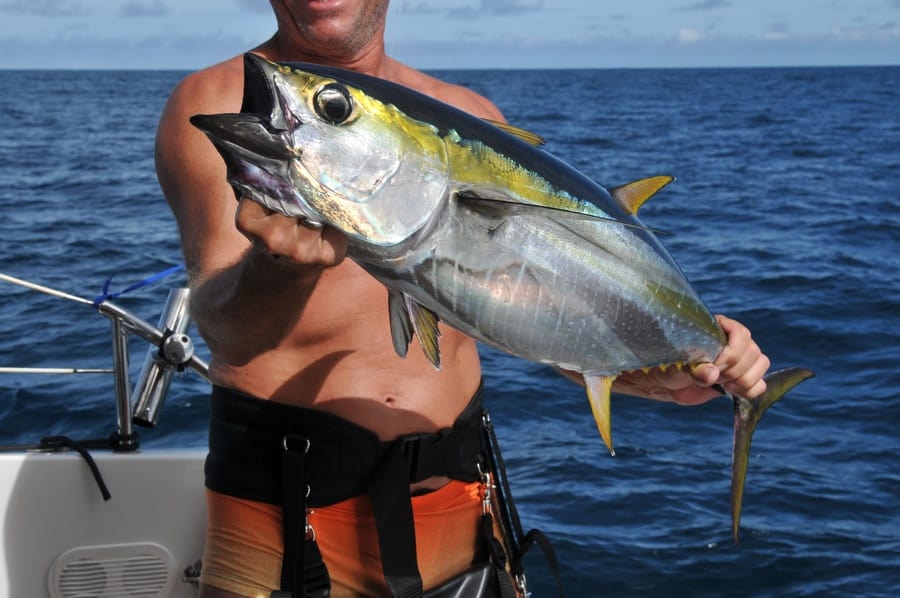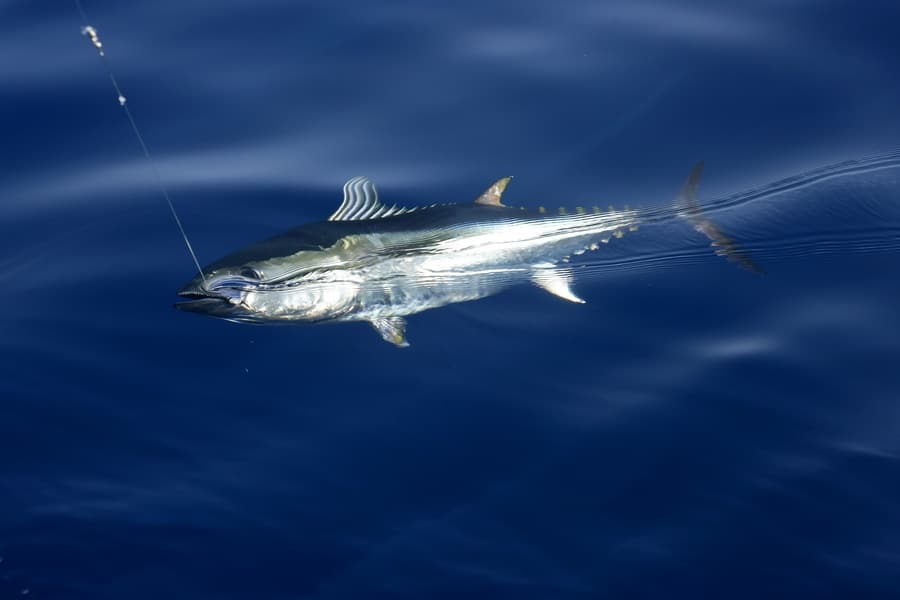Best Water Temperatures for Tuna Fishing (Complete Guide)
Below is a table briefly outlining the preferred water temperatures of six popular species of tuna. On average, the tuna we are looking at prefer water between 66 – 76° F.
| Tuna Species | Best Water Temperature Range |
| Blackfin Tuna | 71-80° F |
| Yellowfin Tuna | 68-76° F |
| Bluefin Tuna | 64-68° F |
| False Albacore | 61-70° F |
| Dogtooth Tuna | 70-80°F |

Is Water Temperature a Big Factor in Tuna Fishing?
Water temperature is definitely important when it comes to tuna fishing. For tuna, water temperature affects several aspects of their life. Of those aspects, the most relevant to fishing is the effect water temperature has on a fish’s metabolism.
In higher water temperatures, tuna metabolize their food more quickly, so they will need more food. Because of that, they will need to hunt more, making them more active in fishing.
One more thing to keep in mind when it comes to water temperature is depth as well. Just because the water temperature closer to the surface is warmer than the preferred water temperature of a specific tuna doesn’t mean they have completely deserted the area.
Tuna are known to retreat to deeper water to avoid higher surface water temperatures during the day only to return to shallower water when it is cooler out.
Seasonal Water Temperature Guide for Tuna
Different species of tuna are more active than others during different parts of the year. Realistically, you can fish for tuna year-round, but you will have more luck with some species than others depending on where and when you fish. There are reasons for each season is different in regard to tuna activity, from temperature to food availability to migratory patterns.
Winter
In Florida, Texas, and Louisiana winter is an excellent time for yellowfin tuna fishing. There is no
closed season per state law in these three states, but Winter and Fall are the times they are
most active.
Florida is king when it comes to Winter yellowfin tuna fishing, particularly on the
Gulf side of the state. Blackfin tuna are also very active during Winter.
Spring
Spring is one of the best times to catch yellowfin tuna off of North Carolina. Yellowfin tuna tend
to have a constant presence in North Carolina, but this time of year they are migrating north
and are especially active.
Summer
Summer is bluefin tuna season in New England. Some of the best bluefin tuna fishing is off the coast of Provincetown down Cape Cod and off of Martha’s Vineyard during the start of the summer months all the way through mid-Fall.
Fall
On the East Coast of the United States tuna are very active during Fall, particularly in North Carolina. During this time of year, false albacore migrate south from New England and are very active for fishing.
The tuna native to North Carolina do tend to be larger than the ones migrating from New England, but both are active during this time of year. Yellowfin Tuna are also active during this time of year.
Tuna Fishing by Water Temperature
Tuna are capable of controlling their internal temperature to a certain degree, but they are still sensitive to changes in water temperature.
51-60° F
This is below the preferred temperature of any tuna we discuss in this article, though not by much for false albacore. Bluefin tuna are known to migrate in temperatures this cold, but they are not going to be good fishing in water this cold.
They are capable of regulating their body temperatures relatively well, but the cold water still affects the temperature of the bluefin tuna’s heart. This is because the gills bring blood directly to the heart, and the gills are directly exposed to the water. So if the water is cold, the blood going to the heart is going to be cold as well.
61-68° F
The average preferred temperature is 66 – 76° F, so water temperatures in the upper range of this section are preferable for most of the tuna we cover in this article.
Two of those tuna though, the dogtooth tuna and blackfin tuna, prefer slightly warmer temperatures. For the rest though you will find them more active and better for fishing.
69-73° F
Water temperatures in this range are a little warm for bluefin tuna and false albacore, but otherwise, these are very good water temperatures for tuna fishing. The other tuna covered in this article will be much more active in warmer water, and because of this, they will need more food to survive.
Of course, because they are feeding more actively, the chances of having your bait taken should be better.
Above 74° F
Temperatures 74 degrees and higher are going to be too high for most of the tuna covered in this article. The exceptions to this are blackfin tuna and dogtooth tuna, which are both comfortable up to 80°.
When the water gets warmer like this, tuna are likely to dive to deeper water to stay comfortable. Adjusting the depth you’re fishing at to a deeper depth should help if you are not having any luck in warmer water.
It’s worth noting that while this range of water temperature is not good for bluefin tuna fishing, hooking bluefins at higher temperatures even within their range runs the risk of cooking the fish.
The temperature of the bluefin tuna’s blood can get so hot during the fight to reel it in that the fish can actually cook itself. This event is known as “burn”, and it can potentially be avoided by bleeding the tuna when you get it onto the boat.
Does Air Temperature Impact Tuna Fishing?
Air temperature is not a very big concern when it comes to tuna fishing. When it comes to fishing in smaller bodies of water, like ponds and lakes, air temperature will have a bigger effect on water temperature.
But ocean water temperatures do not rapidly change because air temperature has changed. The ocean is simply too big, and because of the way that water retains heat it takes long periods of exposure to colder temperatures to really affect water temperature.
This is why ocean water temperatures tend to be warmer during the winter months and cooler during the summer months. It takes a season of exposure to warmer or cooler air temperatures for the water temperature to change.

Best Air Temperature for Tuna?
You can really fish for tuna in any air temperature, water temperature is what you really need to pay attention to. The best temperature for catching the tuna in this article is, on average, between 66° and 76° Fahrenheit.
Now some of the tuna on this fish do prefer water a little cooler than the average, but all of them will be present somewhere within this range.
How Cold is Too Cold for Tuna Fishing?
Temperatures below 60° Fahrenheit are going to be difficult for tuna fishing. Tuna can survive in colder temperatures, but they are more likely either going to be sluggish or they are going to swim toward warmer waters.
How Hot is Too Hot for Tuna Fishing?
Some of the tuna on this list are comfortable in water as warm as 80° Fahrenheit. Water warmer than this though is going to prompt other tuna to dive deeper to find cooler water. With some tuna, like bluefin tuna, you also run the risk of burn at temperatures even lower than 80 degrees.
Storms and Weather Changes
Storms and weather changes can have a variety of effects on fishing conditions. There are several different types of weather that have impacts on fish and their environment including rain, harsh sunlight, wind speed, overcast, temperature, and of course sudden changes in any of these things.
To start, rain impacts fishing in a few ways. Fish in oceanic environments, like the tuna we are discussing in this article, are less active during when it is raining. There is a change in barometric pressure that is uncomfortable for fish with swim bladders when it starts to rain.
There is also a change in barometric pressure that begins to happen hours before it rains that fish are able to sense. They use this time to hunt aggressively so they can dive deeper and wait out the rain once it begins.
Tuna fishing before a rainstorm and after one can yield good results. If you decide to fish for tuna after a rainstorm, look for structures in the water such as oil rigs.
Smaller fish that tuna hunt will use them for cover during a rainstorm, so they will be conveniently gathered in those areas for the tuna as the storm subsides. Rain also has the ability to quickly change water temperature by adding water of a different temperature to a body of water.
For a complete breakdown of the best water temperatures for fishing, check out this guide. For a complete breakdown of the best water temperatures for redfish fishing, check out this guide. For a complete breakdown of the best water temperatures for wahoo fishing, check out this guide.
